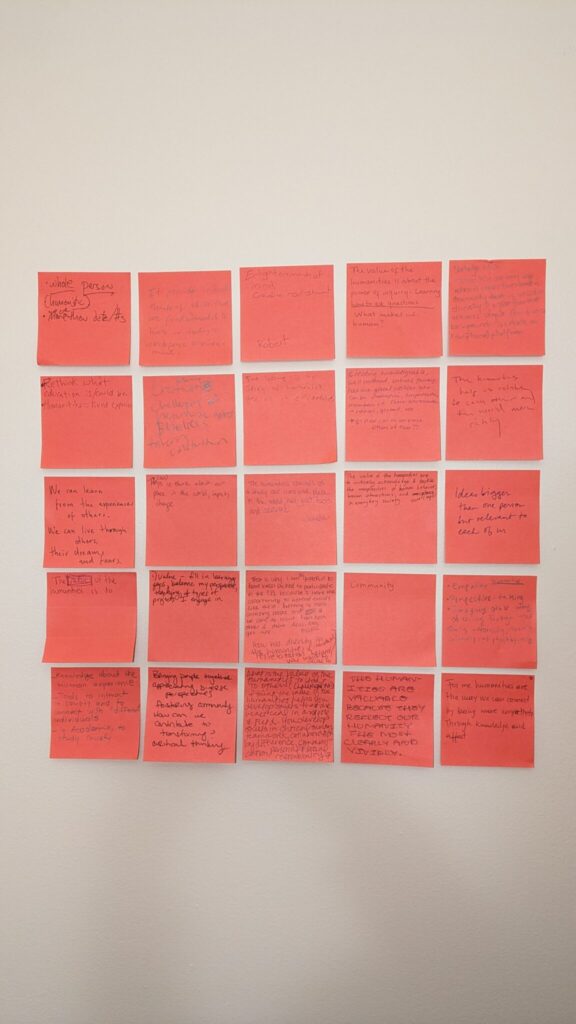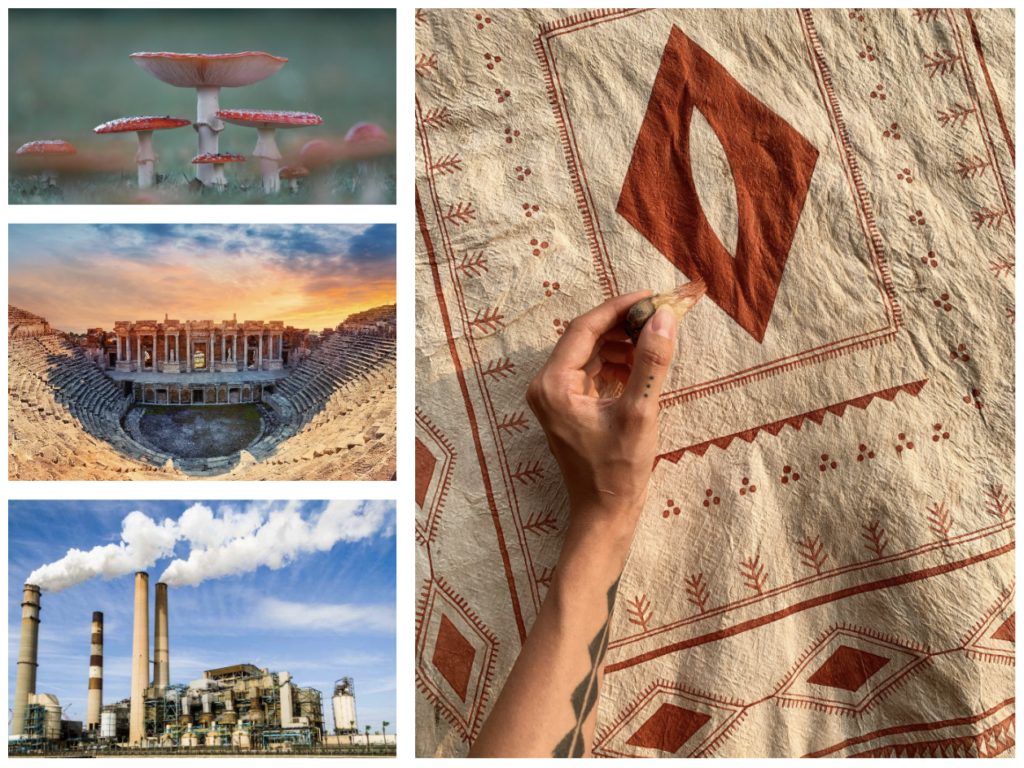On Friday, May 17, 2024, Humanities Alliance directors, staff, graduate fellows, and CUNY Peer Leaders met in the Segal Theatre at the CUNY Graduate Center for an afternoon retreat that included a networking lunch, opening remarks and introductions, presentations from the campus partners, and activities led by Mellon Senior Researcher Dr. Christina Katopodis, and Humanities Director Dr. Luis J. Henao Uribe. Attendees were assigned to roundtables and at each table there was at least one HA staff member, graduate student, and undergraduate student. We had a great turnout from across our partner campuses, and everyone enjoyed seeing one another and catching up in person.
Program Co-Director Dr. Luke Waltzer, who is the Director of the Teaching and Learning Center at the GC, gave opening remarks to set the tone for our gathering. He said that the goal for the day is to put our work from across campuses and the two arms of the program into context for one another. After attendees introduced themselves to one another at the roundtables, we heard presentations from each campus partner and the CPL team.
Dr. Ria Banerjee (Guttman Community College) shared that the fellows at her campus spend the first semester in their first year getting to know the college. The first semester is about introducing fellows to campus by embedding them in courses. In the second semester, the fellows get plugged into a campus-wide Big Read, and each fellow organizes an event as part of the Big Read. This year’s book was Robin Wall Kimmerer’s Braiding Sweetgrass.
Dr. Kristopher Burrell (Hostos Community College) talked about the HA fellowship as a comprehensive professional development experience, including learning all that goes into being a successful faculty member at a community college—beyond teaching—such as the important role of service in advancing your career. With the fellows, he asked, “How do Hostos and CUNY operate? What are the offices, programs, hierarchies?” By being curious together and inviting speakers from different offices across the camps, he and the first-year fellows traverse the college in a year-long orientation. Then those fellows who return for their second year engage in a project-based experience, exploring their interests and what they are most curious to explore about work at community colleges.


Dr. Judy Anderson (Borough of Manhattan Community College) spoke about the fellows’ projects, which spanned numerous disciplines in the humanities: work done toward hosting a Flamenco workshop; a Teaching in Times of Turmoil workshop; organizing a Hip-Hop commission to celebrate the 50-year anniversary of Hip-Hop; an OER conference; working on an Open Lab site; and leading activities with students and a local artist.
Ljubica Depovic and Pablo Avila (LaGuardia Community College) explained that with the brand new office for Global and Experiential Learning (GEL), there were many new and exciting things going on at LaGuardia. The fellows have been thinking about how their research interests are aligned with the GEL office and beginning to make connections. Projects have included an oral history in the interdisciplinary classroom, a seminar on decolonizing teaching, and ePortfolio templates for introducing math and science students to Liberal Arts.
CPL Director Lauren Melendez and Facilitator Kelsey Milian summarized the year with the CUNY Peer Leaders (their biweekly meetups and enrichment outings). CPL Enrique Rodriguez Brito (Queens College) spoke about the inspiration he’s felt in the program—”we were given the guidance to do our best, given an ear when we needed someone to talk to”—and Shehnija Afrin said body-mind mapping was her favorite activity.
After a brief break, I led an inventory activity. Everyone took a red post-it note and wrote down a response to this prompt: “What is the value of the humanities?” Participants could respond to this general question or reframe it as “What is the value for you?” or “What is the value for others?”

After writing down their initial thoughts (I told everyone not to overthink it!), participants turned to a partner to share what they wrote down, then I asked them to gather together as a table to share with their larger group and develop a question from their discussion. The point of an inventory method like this is to engage everyone and get 100% participation (and avoid group think!). Groups shared their questions with the room and I reminded everyone that sometimes we academics and leaders try to be fixers and we try to arrive at answers rather than leave with new questions, so this was an exercise in arriving at bigger questions:
- What do we mean by “value”?
- What is the value of disciplinary boundaries, and how and why does the academy promote and protect those boundaries even as many of us push beyond them?
- How has diversity in the humanities and individual representation influenced your desire to work in the humanities?
- Where is the spirit/politics of solidarity?
- What can we imagine differently? How can we imagine an alternative future and then fight for it?
The discussion that followed segued into our next activity. I put four images face down at every table. We turned them over and I prefaced the activity with a brief story. When I was a graduate student, I had gotten so accustomed to my discipline (English) that I had forgotten other methodologies until I took courses in the Women’s and Gender Studies certificate program. In one course, a student said, “Who cares about 19th century books?” Well, I very much do, but I had taken the importance of my field for granted and realized I had much to learn about other methods and more work to do to show the relevancy of my work and my chosen discipline.

The prompt: “Choose a picture at your table. How would you approach it from your discipline in the humanities, from your position as a teacher, student, facilitator, administrator, activist, etc.?” I asked for a volunteer at each table to raise their hand: someone who would go first and choose a picture to talk about. Then I set a timer for one minute to keep us on time and make room for everyone at the table to have a turn. When the timer went off, I reminded everyone to switch to the next person, who could choose any picture from the table to talk about. We did this on repeat until the table with the largest number of people had finished. Each table had a notetaker who reported back to recap what was discussed. It became clear that in each discussion, every participant started their approach to the image from a specific, different place, but in the end everyone at the table found themselves asking similar questions based on shared human interests, empathies, experiences, and concerns.
If you would like to try adapting these activities as an ice-breaker in your classroom, you can view my slides here.
After a short break, we reconvened for Luis’s activity. Luis asked us to discuss at our tables and each think about what we have learned at the Humanities Alliance. He asked, “How can those experiences benefit someone else in your position (i.e., undergraduate students, graduate students, faculty, scholars, administrators, etc.)?” After robust discussions at our tables, we shared out to the larger group before closing the day’s formal activities. Some participants moved to a social gathering outside the GC.
Special thanks to Miranda Fedock, who helped us to procure food for the networking lunch, and who organizes and managed all the logistics for the day. It was a positive, uplifting, and inspiring gathering and a perfect way to go into the summer.


